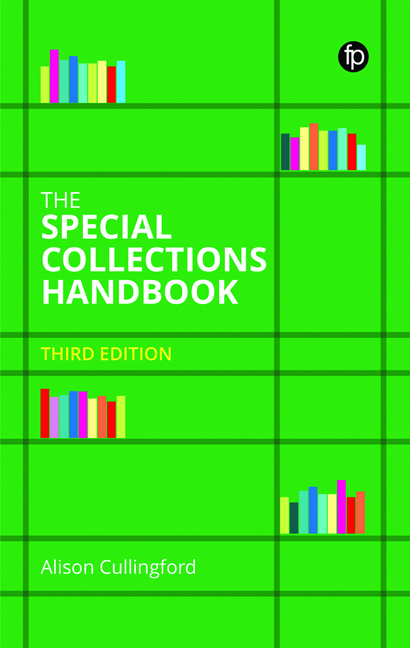Book contents
2 - The Care of Special Collections
Published online by Cambridge University Press: 28 April 2022
Summary
Introducing collections care
The care of collections is the historic basis of Special Collections practice: the decision to offer certain materials a higher level of security and care in response to the perception of their significance and vulnerability. The choices made in caring for collections have long-term, often irreversible effects and must therefore be driven by best professional practice.
This chapter will:
1 Outline threats to collections and how to manage them: the physical composition of objects, environmental factors, pests, mould and mechanical damage.
2 Review the management of storage, shelving and materials to promote collections care, including historic libraries and management of unoccupied buildings.
3 Examine the risks posed by handling and exhibitions and how to manage them.
4 Explore the role of the conservator.
5 Introduce preservation reformatting and the challenges of digital preservation.
6 Discuss how to improve collections care via audits, benchmarking and policies.
7 Suggest further reading and useful websites.
A note on terminology
The terminology of collections care can be confusing. I follow the definitions used in the current standard for cultural collections management, PAS 197 (British Standards Institution, 2009):
• Collections care: ‘range of activities intended to safeguard a collection. These activities can include organisational policies, security, storage, cleaning, maintenance, handling, scientific investigation, environmental monitoring and control, exhibitions and loans, conservation, provision of surrogates, and emergency planning.’ Collections care is also known as preservation and preventive conservation.
• Conservation: ‘interventive techniques applied to an item to achieve chemical and physical stabilization for the purpose of extending the useful life of the item to ensure its continued availability.’ Also known as interventive conservation and remedial conservation.
• Restoration is not defined in PAS 197: it usually implies an approach to conservation that aims to recreate an item ‘to a known or assumed original state’, by removing later additions and replacing missing parts (ICON website, www.icon.org.uk).
A note on standards
Many guidelines and standards have been developed to help organisations provide appropriate levels of care for heritage materials. This chapter picks out the key points in the standards; the audits and benchmarking methods covered below help librarians move practice closer to the requirements of the standards.
The key standards for UK libraries in 2021 are:
• BS 4971:2017 (British Standards Institution, 2017) Conservation and care of archive and library collections.
- Type
- Chapter
- Information
- The Special Collections Handbook , pp. 31 - 62Publisher: FacetPrint publication year: 2022



